By BRENDA JOSEPHSON
Alaska’s abundance of seafood allows us to anchor our cuisine around salmon, halibut, crab, and shellfish caught in our pristine waters. Yet, we frequently miss opportunities to include the savory umami flavor that seaweed offers to satiate and nourish the body.
The Gulf of Alaska is home to thousands of species of seaweed, many of which are edible. Some of the most common edible seaweeds along our coastline include red ribbon seaweed/dulce (Palmaria mollis), black seaweed/nori (Porphyra), and popweed/rockweed (Fucus). Large brown seaweeds are known as kelp with numerous species that are abundant in our region, including bull kelp (Nereocystis luetkeana), giant kelp (Macrocystis), sugar kelp (Saccharina latissimi), split kelp (Saccharina groenlandica), winged kelp (Alaria marginata), and five-ribbed kelp (Costaria costata).
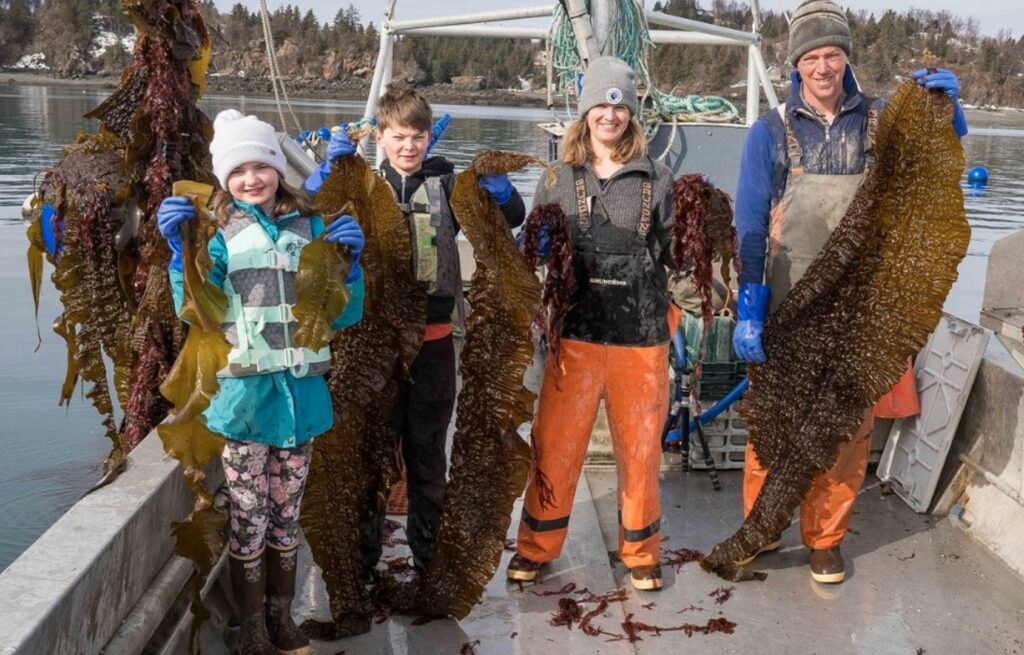
Photos and more information on common species of seaweed are available by clicking on this link: Seaweeds of Alaska
A guidebook with information on our region’s seaweeds has made foraging easier. Dolly Garza, who was with the University of Alaska Fairbanks, Alaska Sea Grant College Program, authored “Common Edible Seaweeds in the Gulf of Alaska,” which is now in its second edition. With extensive instructions on how to identify, gather, process, and prepare seaweed, as well as recipes, it has become the de facto standard for seaweed foraging in Alaska.
The guidebook is available on the National Oceanic and Atmospheric Administration’s website in the NOAA Institutional Repository and on the Oceans Alaska website at this link: Common Edible Seaweeds in the Gulf of Alaska.
Subsistence seaweed collection usually occurs in the spring and summer along the coastline during low tides. However, you can gather some species, like bull kelp and sugar kelp, throughout the summer and into the autumn.
The edible kelp species are among the most commonly gathered seaweeds. You can easily process kelp for long-term storage by hanging it on a line or laying it out on a sheet to dry. As the kelp dries, the salts and/or sugars may turn into a powdery white coating on the blades. This may look disconcerting, but it is a normal part of the edible product. Storage of dried seaweed in an airtight container or zippered plastic bags allows for use up to a year later.
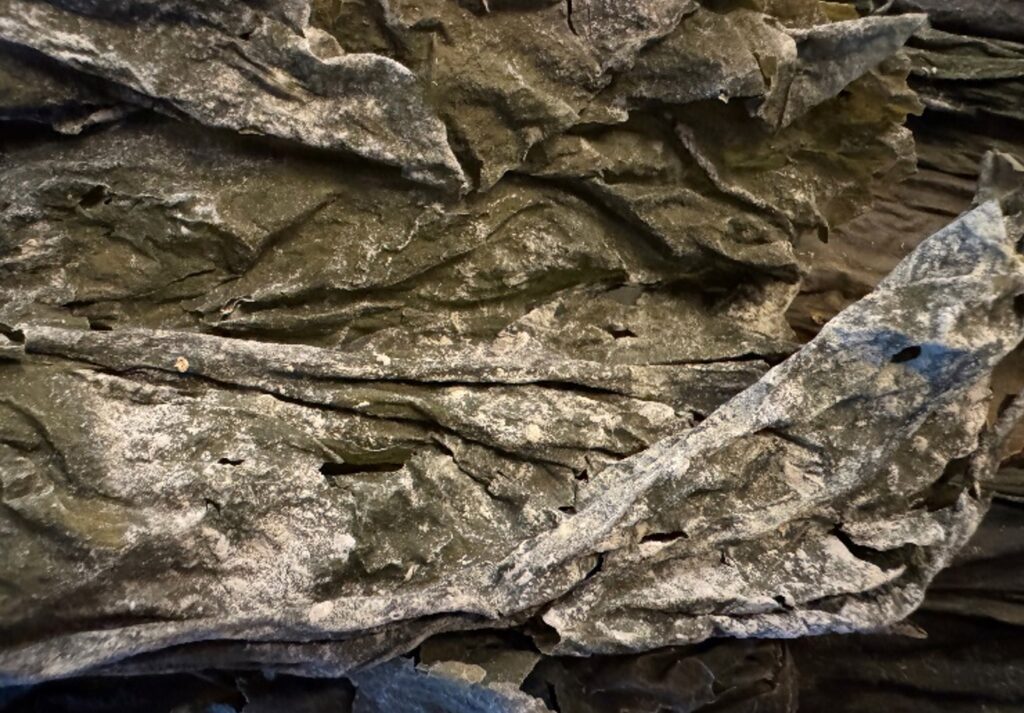
Edible seaweed lends itself nicely to a wide range of culinary applications. Similar to kale chips, you can transform fresh kelp into crispy snacks by heating the strips in a frying pan with avocado oil. Or if you prefer an oil-free chip, you can dry fresh seaweed in a low oven from 150 to 200 degrees until the kelp is crisp. There are numerous other ways to enjoy kelp, such as incorporating it into a salad, pairing it with seafood, using it as a vegetable substitute in various dishes, or adding it for umami essence to enhance pasta, stir-fry, and chowders.
Bull kelp (Nereocystis luetkeana) is one of the largest brown kelp species in the North Pacific and a popular foraging species in Southeast Alaska. People commonly use skiffs for collection because they thrive in deeper water. For optimal results, harvest it in late spring or early summer, but you can gather it until the fall.
Pickles, chutneys, salsas, and relish are made from the thicker, hollow stipe (stem) portions of bull kelp while they are still fresh. The stipe is sliced and processed into pickles in a manner similar to pickling cucumbers. Chutney, salsa, and relish are made by chopping the stipe and then blending it with additional ingredients and seasoning. Then, it is canned for long-term storage.
Mark Stopha forages for bull kelp off of Prince of Wales Island. While many other seaweeds are available in the region, bull kelp is his preferred species to harvest. He has stated that he targets bull kelp because he can sustainably harvest a 5-gallon bucket of bull kelp stipes in a few minutes, which provides enough product to meet his subsistence needs for the year. He processes it into kelp salsa and kelp relish, then preserves it in a canner for extended storage.
The recipe for Mark’s Bull Kelp Relish is at the end of this post.
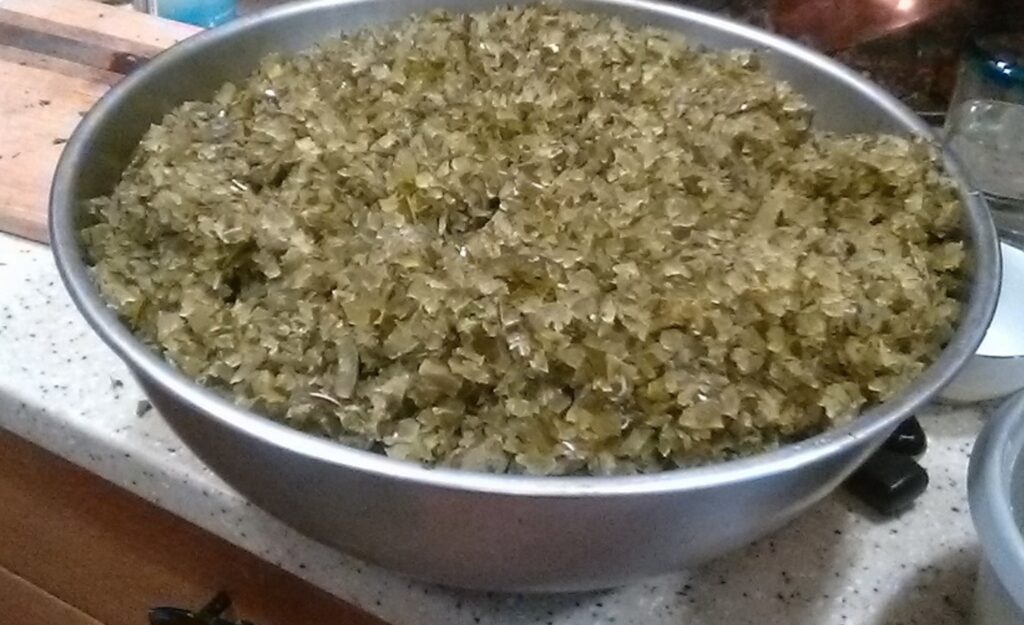
The State of Alaska’s website provides information on harvesting seaweed in Alaska. On the state’s site it is stated that, “Along most of Alaska’s coastline it’s okay to harvest kelp for personal, noncommercial use… However, always check with your regional office to make sure there are not any emergency closures in your area.”
For more guidance from the State of Alaska on harvesting kelp click this link: Harvesting Seaweed and Other Aquatic Plants in Southcentral Alaska
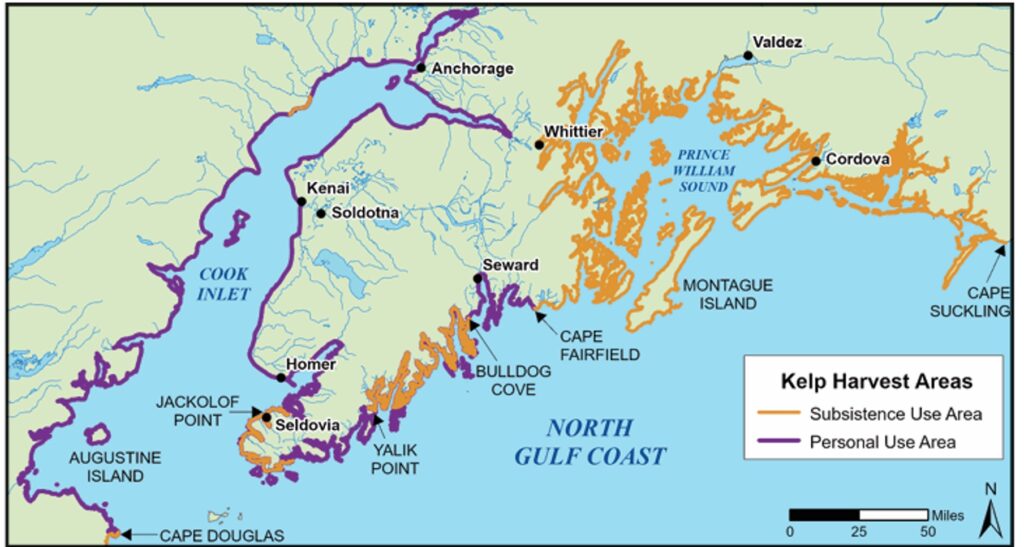
Foragers are not the only ones who can enjoy the umami taste sensations of our coast. Alaska-sourced commercial products are a wonderful option for those who lack the enthusiasm or ability to gather seaweed.
Alaska’s commercial seaweed industry is still in its infancy, but efforts are underway to expand commercially available kelp products.
Video: NOAA Fisheries Kelp Farming
Alaska is spearheading the expansion of mariculture, including seaweed, by providing financial support to private businesses through a program designed to encourage investment in the industry. The State of Alaska, through the Department of Commerce, Community, and Economic Development, allocated $5 million to the Alaska Mariculture Alliance in 2022 to administer a Mariculture Incentive Grant Program. Shellfish, seaweed, hatchery, and mariculture processing enterprises can receive up to $150,000 per award cycle from this program.
The Alaska Mariculture Alliance’s executive director, Jason Lessard, believes that the incentive grants will significantly expand the state’s mariculture sector. “AMA is proud to partner with the State for this unique program, which will ultimately translate into about $9 million of investment in Alaska Mariculture,” Lessard stated. He added that they are “only part way through the Round One grant period and already starting to see tangible improvements in operations across the state. This grant will have transformational impacts on Alaska Mariculture for years to come.”
On October 15th, the Alaska Mariculture Alliance announced that they will accept applications for Round 2 of the Mariculture Incentive Grant Program until Dec. 15. To learn more about the grants available to mariculture firms, click on this link: AMA Grant Round Two
There are already a small number of kelp farms producing for the commercial market.
Seagrove Kelp cultivates ribbon kelp, commonly referred to as winged kelp (Alaria marginata), at its Doyle Bay plant on Prince of Wales Island. Consumers in Alaska and Washington State can purchase their products in retail outlets in 1-pound frozen packets. They also supply kelp to commercial processors who produce finished seaweed products.
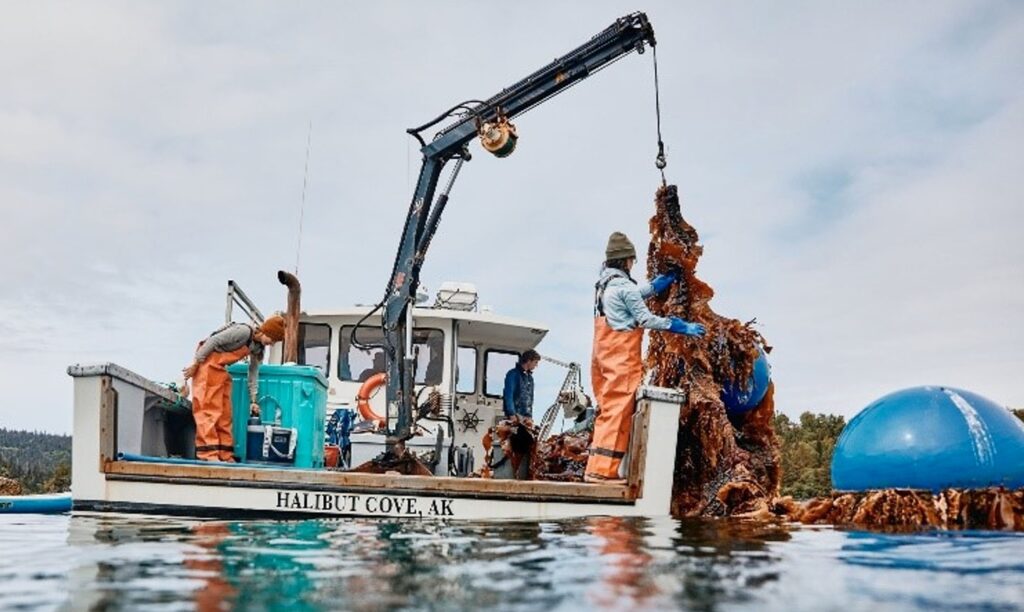
Alaska Shellfish Farms is a family-run mariculture enterprise located in Halibut Cove on the Kenai Peninsula in Alaska, owned and operated by Weatherly and Greg Bates. They cultivate oysters, mussels, and kelp for the consumer market. Kachemak Bay’s glacier-fed water nurtures the oysters for three to four years. According to Weatherly, the chilly waters and shellfish suspension lines create ideal conditions for the growth of five ribbed/costaria kelp (Costaria costata) and red ribbon/dulse (Palmaria mollis) species. They harvest the kelp as a sustainable byproduct of their shellfish farm.
The kelp is packaged for sale in quart-sized mylar bags that hold one ounce of dried product. The Costaria Kelp and Dulse easily rehydrates, making it suitable for a wide range of culinary applications. Weatherly describes kelp as a nutrient-dense superfood that her family enjoys with their meals on a regular basis. Her favorite way to eat the costaria kelp is in a marinated seaweed salad with rice vinegar, sesame oil, and seasonings. The recipe she uses elevates the kelp’s umami flavor to perfection, leaving you wanting more after just one taste. This recipe is undoubtedly a must-try, even if you are new to adding seaweed to your meals.
Below is the recipe Weatherly uses for her Kelp Salad.
Another option for including seaweed with your meals is to purchase finished products made for the consumer retail market. A few companies are making seaweed-based finished goods available in gift shops and supermarkets. Two companies that use seaweed in their products include Barnacle Foods of Juneau and Foraged & Found of Ketchikan. Both enterprises incorporate Alaska-sourced kelp into their finished products, including kelp pickles, salsa, and more.
Seaweed is more than just a wrap for sushi. It is a nutrient-rich and adaptable food that brings forth the flavors and textures from the coast to tantalize the palate with its umami essence. It is a natural complement to Alaska’s seafood, satiating on its own as pickles, chips, or salad and a healthy vegetable alternative in a variety of dishes.
Alaskans can obtain seaweed by foraging, purchasing frozen or dried kelp, or buying finished products. Regardless of how it finds its way to your table, you can enjoy our region’s unique offerings and savor the local flavor.

Kelp Salad
Recipe provided by Weatherly Bates
- 1 ounce dried kelp
- 1 ½ tablespoons rice vinegar
- 1 tablespoon mirin sweet cooking rice wine
- 3 tablespoons sesame oil
- 1 ½ tablespoons soy sauce
- ¼ teaspoon ginger powder
- ¼ teaspoon garlic powder
- 2 tablespoons sesame seeds
- ¼ teaspoon chili flakes
- Optional topping with additional sesame seeds
- Rehydrate kelp in fresh water for 10 minutes, drain, cut into thin strips
- Combine ingredients to make a sauce, toss with seaweed, and marinate for at least 30 minutes (up to 2 days)
- Enjoy
Makes 4 servings.
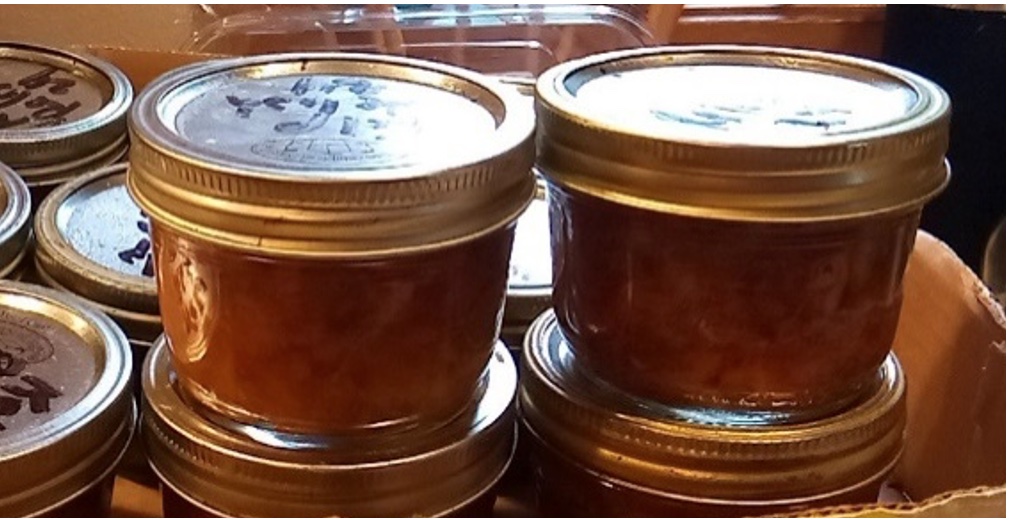
Bull Kelp Relish
Recipe provided by Mark Stopha
- 18 cups ground bull kelp stipe*
- 1 medium large green cabbage
- 1 medium red cabbage
- 6 white onions
- 18 carrots (2 bags)
- 2 green peppers
- 3 cups sugar
- 8 cups white vinegar
- 2 tablespoon tumeric
- 4 tablespoon mustard seed powder
- Rinse bull kelp in fresh water.
- Chop or grind kelp, cabbages, onions, carrots, and peppers.
- Mix all ingredients in a large stockpot and simmer for 2 hours.
- Fill prepared jars for canning.
- Heat in a boiling water bath for 10 minutes, or as directed by your canning instruction book ensuring that all safe canning guidelines are followed.
Makes approximately 60 half pint jars.
*Mark’s Tip: “Instead of using a food processor, you can use a food grinder for the kelp and all the vegetables. It comes out great as all the items are the same size coming out of the grinder.”
Brenda Josephson is a Haines resident. She is an accounting and tax professional, real estate agent, professionally trained chef, and advocate for good governance. She spends her time fishing, foraging, and savoring Alaska’s abundance of natural and wild foods with her family.
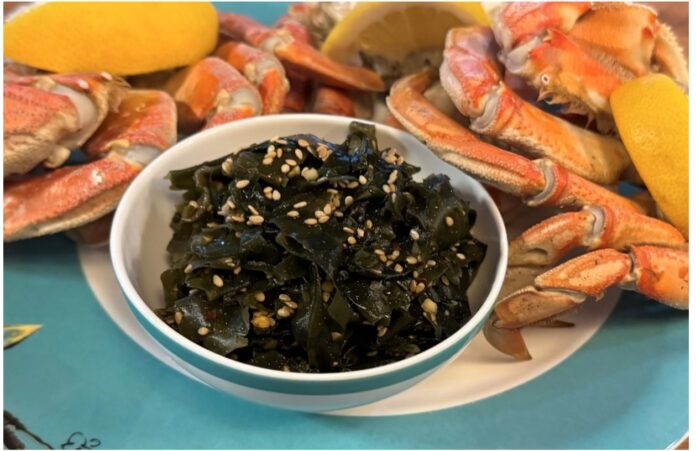
No mention of Southeast Alaska’s Tlingit, Haida and Tsimshian people in this article. We have been harvesting seaweed for centuries as a main staple of our diet. It’s delicious!
Yes it is.
No mention of Chileans who have been using bull kelp for at least 14,000 years (‘https://www.atlasobscura.com/foods/cochayuyo-seaweed-chile) or Japanese who used it at least that long. It’s not all about the past. Not all about the Lingits, or northwest tribes, although I’d welcome a Tlingit recipe that combined kelp with other delicious ingredients. Please share one.
Minorities.
They are always offended by something, always.
Jeez.
As my grandfather, who was born in 1893, would say to us when we were, “crying in our cheerios” – “no one cares, work harder”.
Or maybe we can start talking about the slavery between all the Alaska tribes – before the evil white man was even here…
Some have reason to be. Chained, raped, whipped like a mule, forced to march while sick and starving, paid lesser wages, yeah, how dare they be cross.
Read up on the Supreme Court decision to stop slavery in Alaska – 35 years after the practice was banned in the Lower 48.
1 out of every 3 people in SE Alaska was a slave.
Ever hear of the Grease Trail? Where they called a truce every year to stop warring against each other – murdering / raping / slaving – to collect the hooligans.
The word Slave comes from the word Slave – whites were being enslaved by Persians, Arabs, and North Africans.
That’s why President Thomas Jefferson created the US Marines – to stop the Barbary Pirates in the Mediterranean and North Atlantic from capturing US citizens for the slave trade.
The USA was the second country in the world to end slavery, right behind Great Britian.
Slavery is still practiced in much of the world – middle east, Africa, India, China, and the South Pacific .
Don’t let facts, history, and truism to get in the way of your hatred for western civilization.
You’ve been played.
Sad, really.
I’ve had kelp salsa, it could have been good but I didn’t care for the flavor profile, the kelp was a good base but the other ingredients weren’t my thing. I’d like to try kelp pickles, they seem like they’d be delicious.
Kelp, you guys. The article was about kelp…
Got anything to contribute?
I am sorry, I have no kelp.
Available on Amazon in the form of chips. A little salty but delicious.